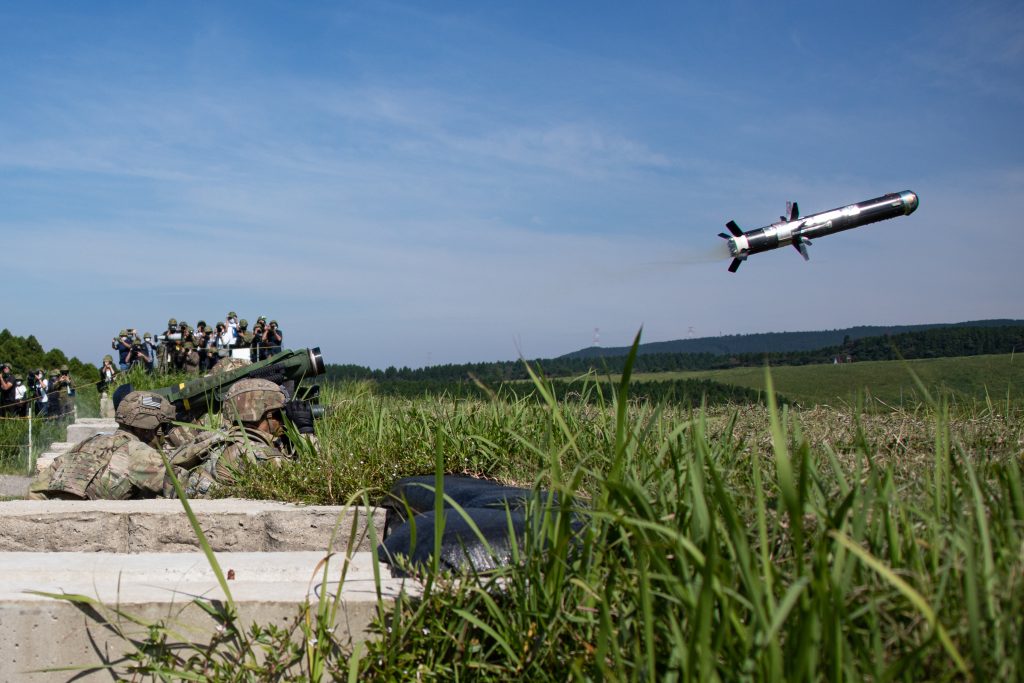
HIMARS: Soldiers from the Kansas National Guard’s 130th Field Artillery Regiment train with their High Mobility Artillery Rocket Systems (HIMARS) in September 2022 at Camp Arifjan, Kuwait. (Photo by Sgt. Nicholas Ramshaw, 35th Infantry Division)
FROM THE ARMY ACQUISITION EXECUTIVE DOUGLAS R. BUSH

The U.S. Army is playing a vital role in the U.S. government’s response to Russia’s invasion of Ukraine. The effort has been going on for just over one year now. We are employing all the authorities and generous funding from Congress and working closely with our industry partners to dramatically increase production rates across the board, while also providing Ukraine with equipment from our stockpiles. Moreover, we are working with allies and partners on their production capacity to maximize our support for the war effort.
Now that we are operating at full speed, the Army has a particular focus on ramping up production of artillery and various munitions, especially, precision munitions. Systems such as Javelin, Stinger, Guided Multiple Launch Rocket System (GMLRS) and High Mobility Artillery Rocket System (HIMARS) launchers are crucial to the Ukrainian war effort. This is a significant ongoing effort that consumes much of my day.
PRODUCTION CAPACITY
Our effort began in earnest early last summer as the conflict escalated and lengthened in time. We went through a deliberate effort to start planning for the production ramp-ups that are currently underway. This included working with industry partners and securing congressional support for the billions of dollars needed to support the necessary expansion of production. Now that we are past the planning phase, we are in full execution mode.
Although some people were surprised by the initial timelines to increase production, the Army was not. These are significant and sophisticated manufacturing operations. Consider a “simple” artillery shell. There’s a fuse, the shell itself, the primer and the charges that launch it from an artillery tube. All these parts have their own detailed supply chains behind them and are manufactured in facilities that are geographically dispersed. Therefore, it is not just the prime contractors or the Army depots; it is everything underneath them.
We have made a concerted effort to energize all these production variables across the board because we do not know how long the war in Ukraine will last. Furthermore, we are taking a maximalist approach, because in not knowing how long the war will last, we also don’t know how low our stockpiles will diminish. Regardless of the war’s duration, we must maintain supply for Ukraine, while replenishing our own stocks post-conflict.
PULLING RAMP-UP CURVE ‘LEFT AND UP’
The war in Ukraine has reinforced the traditional notion that the U.S. is the arsenal of democracy. As far as I am concerned, we are.
The Army supports this in at least three ways. The first relies on the Army’s organic industrial base, which is dedicated to conventional munitions. It turns out that the Army made a good long-term bet by investing in and maintaining our own ammunition plants. Without those investments in government-owned, contractor-operated plants, we would be lagging far behind where we are today.
The second part is modernizing and improving what is in those facilities. My predecessor, Dr. Bruce Jette, in partnership with then-Gen. Edward Daly at Army Materiel Command, had the foresight to begin making those improvements before the conflict started. Coupled with Congress supporting us with more than $1.5 billion in additional funds already under contract to execute those modernizations, we are moving much faster than we thought possible. This represents a long-term investment that puts us in a position of strength today and post-conflict.
The third part is the private sector, which is a bit different. We are dependent on the private sector for producing our precision munitions. Therefore, we are working with prime contractors to ramp up their production capacity. What is different today is that we have secured congressional funding to subsidize our contracting partners to boost their production. Often, we can count on them to finance that themselves, but in the interest of speed, we are taking steps to shift the production curve left and up to get ramp-ups to happen more quickly.

JAVELIN LIVE FIRE: Soldiers with the 11th Airborne Division fire a Javelin Anti-Tank Missile System in August 2022. The Javelin is used as an anti-tank missile to disable vehicles with one round and is a key system for Ukraine support. (Photo by Pfc. Wyatt Moore, 28th Public Affairs Detachment)
ALLIES AND PARTNERS
The conflict has caused many of us to recognize the need for additional production capacity from our allies. This is something, particularly the U.S., would benefit from. Additional capacity adds redundancy by mitigating our risk of production delays due to single points of failure within the supply chain.
We are already seeing positive moves toward that end. For instance, Australia has expressed great interest in developing precision munitions production capacity, and we are working with them to make that happen. In Europe, Poland is a leader in wanting to expand its domestic production capacity, specifically with systems such as Javelin.
There is plenty of work to go around and our allies and partners stand to benefit as much as we do. Democracies working together to develop a giant arsenal is a total win-win.
EARLY LESSONS LEARNED
So far, we have learned two major lessons from supporting the Ukraine mission. First, we must work hard to ensure that our requirements for pre-war reserves are at the right levels. Simply stated, we can manage longer production ramp-up times by having a larger stockpile at the start of a conflict. That effort is underway far above me at the Pentagon.
Even so, stockpiles are expensive to build and maintain. Some must be stored in controlled environmental conditions and others require an inspection regime. All of this requires money. These are policy questions that are being worked on at the Pentagon and on Capitol Hill.
Second, we need to think about how we plan for mobilizations. For example, perhaps our pre-positioned stocks of raw materials, such as steel for artillery shells, ought to be procured far in advance. And, possibly stockpiling in quantities greater than what we have historically maintained. It is a careful balance because excess capacity is economically inefficient. That is, having equipment sitting idle on a factory floor, but paying to maintain it, is risky because it could be obsolete within a few years.
Yet, we have seen within our own ammunition plants instances where we did maintain machinery and production capacity that is being used today. Clearly there is a careful balance to strike when making these sorts of policy decisions.
CONGRESSIONAL SUPPORT
Congress has been very supportive of our efforts with respect to Ukraine. It has granted us some targeted and vitally important contracting streamlining authorities in the 2023 National Defense Authorization Act. This has led to dramatically reduced contracting timelines specifically for Ukraine. Of course, the Department of Defense always desires more flexible funding, but so far in the case of Ukraine, Congress has found a good balance between flexibility and carrying out its fiscal oversight responsibilities. Maintaining this support requires us to be highly efficient and 100 percent transparent with Congress.
ACQUISITION WORKFORCE
Nothing we have accomplished with Ukraine would be possible without the more than 32,000 Soldiers, civilians and contractors that make up the acquisition workforce. The machinery of my department runs through the program executive offices (PEOs) and my deputy assistant secretaries. The actual tactical work on acquisition all happens at the PEOs and the contracting centers that support them. I am very humbled to be leading this dedicated and talented team of professionals. They do all the hard work and I could not be prouder of them. The team has worked wonders this past year, but we aren’t done yet and much more work lies ahead of us.







